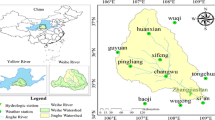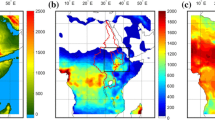Abstract
Ten models of NEX-GDDP CMIP5 were used to perform equal-weighted averaging under the RCP4.5 and RCP8.5 scenarios to obtain daily precipitation and temperature data under a multi-model ensemble. The CREST and VIC models were used to project the change characteristics of runoff and precipitation in the Xijiang River Basin under the background of a global warming by 1.5 °C and 2 °C, respectively. The results show that: (1) under the two warming target scenarios, there are obvious regional differences in the extreme precipitation in the Xijiang River Basin under the RCP4.5 and RCP8.5 scenarios. The precipitation increases on the whole and more so under the high-emission and greater-warming scenarios. In addition, extreme precipitation events in the Xijiang River Basin are significantly different at a temperature rise of additional 0.5 °C. (2) CREST and VIC have good feasibility in the Xijiang River Basin. The projected runoff increases under different combinations of scenarios and at various time scales compared to the baseline period. (3) There is no significant difference between the multi-annual average monthly runoff distribution percentage calculated by the multi-model and hydrological model ensemble average and the multi-annual average monthly runoff distribution percentage during the baseline period and the distributions under the RCP 4.5 and 8.5 scenarios are more uniform and uneven, respectively, than that in the baseline period.











Similar content being viewed by others
References
Bao Y, Wen X (2017) Projection of China’s near- and long-term climate in a new high-resolution daily downscaled dataset NEX-GDDP. J Meteorol Res 31(1):236–249
Chen H, Sun J (2015) Changes in climate extreme events in China associated with warming. Int J Climatol 35(10):2735–2751
Chen L, Chang J, Wang Y et al (2019) Assessing runoff sensitivities to precipitation and temperature changes under global climate-change scenarios. Hydrol Res 50(1):24–42
Dams J, Nossent J, Senbeta TB, Willems P, Batelaan O (2015) Multi-model approach to assess the impact of climate change on runoff. J Hydrol 529:1601–1616
Das J, Umamahesh NV (2018) Assessment of uncertainty in estimating future flood return levels under climate change. Nat Hazards 93(1):109–124
Das J, Treesa A, Umamahesh NV (2018) Modelling impacts of climate change on a river basin: analysis of uncertainty using REA and possibilistic approach. Water Resour Manag 32(15):4833–4852
Döll P, Trautmann T, Gerten D et al (2018) Risks for the global freshwater system at 1.5 C and 2 C global warming. Environ Res Lett 3(4):044038
Dong N, Yu Z, Yang C, Yang M, Wang W (2019a) Hydrological impact of a reservoir network in the upper Gan River Basin, China. Hydrol Process 33(12):1709–1723
Dong N, Yu Z, Gu H, Yang C, Yang M, Wei J, Wang H, Arnault J, Laux P, Kunstmann H (2019b) Climate-induced hydrological impact mitigated by a high-density reservoir network in the Poyang Lake Basin. J Hydrol 579:124148
Donnelly C, Greuell W, Andersson J et al (2017) Impacts of climate change on European hydrology at 1.5, 2 and 3 degrees mean global warming above preindustrial level. Clim Change 143(1–2):13–26
Dottori F, Szewczyk W, Ciscar JC et al (2018) Increased human and economic losses from river flooding with anthropogenic warming. Nat Clim Change 8(9):781
Filahi S, Tanarhte M, Mouhir L, El Morhit M, Tramblay Y (2016) Trends in indices of daily temperature and precipitations extremes in Morocco. Theor Appl Climatol 124(3–4):959–972
Huang S, Kumar R, Rakovec O et al (2018) Multimodel assessment of flood characteristics in four large river basins at global warming of 1.5, 2.0 and 3.0 K above the pre-industrial level. Environ Res Lett 13(12):124005
Hulme M (2016) 1.5 C and climate research after the Paris Agreement. Nat Clim Change 6(3):222
IPCC (2013) Climate change 2013: the physical science basis. Contribution of working group 1 to the fifth assessment report of the intergovernmental panel on climate change. Cambridge University Press, Cambridge
Karmalkar AV, Bradley RS (2017) Consequences of global warming of 1.5°C and 2°C for regional temperature and precipitation changes in the contiguous United States. PLoS ONE 12:e0168697
Khan SI, Hong Y, Wang JH, Yilmaz KK, Gourley JJ, Adler RF (2011a) Satellite remote sensing and hydrologic modeling for flood inundation mapping in Lake Victoria basin: implications for hydrologic prediction in ungauged basins. IEEE Trans Geosci Remote Sens 49(1):85–95
Khan SI, Adhikari P, Hong Y, Vergara H, Adler RF, Policelli F (2011b) Hydroclimatology of Lake Victoria region using hydrologic model and satellite remote sensing data. Hydrol Earth Syst Sci 15(1):107–117
Lehner F, Coats S, Stocker TF et al (2017) Projected drought risk in 1.5 C and 2 C warmer climates. Geophys Res Lett 44(14):7419–7428
Li W, Jiang Z, Zhang X, Li L, Sun Y (2018) Additional risk in extreme precipitation in China from 1.5 °C to 2.0 °C global warming levels. Sci Bull 63:228–234
Li Z, Guo X, Yang Y et al (2019) Heatwave trends and the population exposure over China in the 21st century as well as under 1.5 C and 2.0 C global warmer future scenarios. Sustainability 11(12):3318
Liang X, Lettenmaier DP, Wood EF et al (1994) A simple hydrologically based model of land surface water and energy fluxes for general circulation models. J Geophys Res Atmos 99(D7):14415–14428
Liu L, Xu H, Wang Y, Jiang T (2017) Impacts of 1.5 and 2 C global warming on water availability and extreme hydrological events in Yiluo and Beijiang River catchments in China. Clim Change 145(1–2):145–158
Lohmann D, Raschke E, Nijssen B et al (1998) Regional scale hydrology: I. Formulation of the VIC-2L model coupled to a routing model. Hydrol Sci J 43(1):131–141
Meng-Zi Z, Guang-Sheng Z, Xiao-Min L, Li Z, Yu-He JI (2018) CMIP5-based threshold-crossing times of 1.5°C and 2°C global warming above pre-industrial levels. Clim Change Res 14:221–227
Mitchell D et al (2017) Half a degree additional warming, prognosis and projected impacts (HAPPI): background and experimental design. Geosci Model Dev 10:571–583
Nilawar AP, Waikar ML (2018) Use of SWAT to determine the effects of climate and land use changes on streamflow and sediment concentration in the Purna River basin, India. Environ Earth Sci 77(23):783
Paltan H, Allen M, Haustein K et al (2018) Global implications of 1.5 °C and 2 °C warmer worlds on extreme river flows. Environ Res Lett 13(9):094003
Rogelj J, Den Elzen M, Höhne N et al (2016) Paris Agreement climate proposals need a boost to keep warming well below 2 C. Nature 534(7609):631
Rosenbrock HH (1960) An automatic method for finding the greatest or least value of a function. Comput J 3(3):175–184
Schellnhuber HJ, Rahmstorf S, Winkelmann R (2016) Why the right climate target was agreed in Paris. Nat Clim Change 6(7):649
Shen Y, Xiong AY (2016) Validation and comparison of a new gauge-based precipitation analysis over mainland China. Int J Climatol 36:252–265
Shen Y, Zhao P, Pan Y, Yu JJ (2014) A high spatiotemporal gauge-satellite merged precipitation analysis over China. J Geophys Res Atmos 119(6):3063–3075
Silberstein RP, Aryal SK, Durrant J, Pearcey M, Braccia M, Charles SP (2012) Climate change and runoff in south-western Australia. J Hydrol 475:441–455
Tang GQ, Zeng ZY, Long D, Guo XL, Yong B, Zhang WH (2016) Statistical and hydrological comparisons between TRMM and GPM level-3 products over a midlatitude basin: is day-1 IMERG a good successor for TMPA 3B42V7? J Hydrometeorol 17(1):121–137
Thrasher B, Maurer EP, Duffy PB et al (2012) Bias correcting climate model simulated daily temperature extremes with quantile mapping. Hydrol Earth Syst Sci 16:3309–3314
Wang J, Hong Y, Li L et al (2011) The coupled routing and excess storage (CREST) distributed hydrological model. Hydrol Sci J 56(1):84–98
Xie Z, Su F, Liang X et al (2003) Applications of a surface runoff model with Horton and Dunne runoff for VIC. Adv Atmos Sci 20(2):165–172
Xu Y, Xu CH (2012) Preliminary assessment of simulations of climate changes over China by CMIP5 multi-models. Atmos Ocean Sci Lett 5(6):489–494
Yuan F, Xie Z, Liu Q et al (2004) An application of the VIC-3L land surface model and remote sensing data in simulating streamflow for the Hanjiang River basin. Can J Remote Sens 30(5):680–690
Zhou M, Zhou G, Lv X et al (2019) Global warming from 1.5 to 2 °C will lead to increase in precipitation intensity in China. Int J Climatol 39(4):2351–2361
Zhu DH, Samiran Das, Ren QW (2017) Hydrological appraisal of climate change impacts on the water resources of the Xijiang Basin, South China. Water 9(10):793
Acknowledgements
We are very grateful to the editors and anonymous reviewers for their critical comments and thoughtful suggestions.
Funding
This study was funded by the National Key R&D Program of China (Grant No. 2018YFC0407701) and Natural Science Foundation of China (Grant No. 71461010701).
Author information
Authors and Affiliations
Contributions
Conceptualization: YZ and ZL; Methodology: YZ and SC; Writing-original draft preparation: YZ; Writing-review and editing: YZ and HW. All authors read and approved the final manuscript.
Corresponding author
Ethics declarations
Conflict of interest
The authors declare that they have no conflict of interest.
Additional information
Publisher's Note
Springer Nature remains neutral with regard to jurisdictional claims in published maps and institutional affiliations.
Appendix
Appendix
See Fig. 12.
Rights and permissions
About this article
Cite this article
Zhao, Y., Li, Z., Cai, S. et al. Characteristics of extreme precipitation and runoff in the Xijiang River Basin at global warming of 1.5 °C and 2 °C. Nat Hazards 101, 669–688 (2020). https://doi.org/10.1007/s11069-020-03889-x
Received:
Accepted:
Published:
Issue Date:
DOI: https://doi.org/10.1007/s11069-020-03889-x





